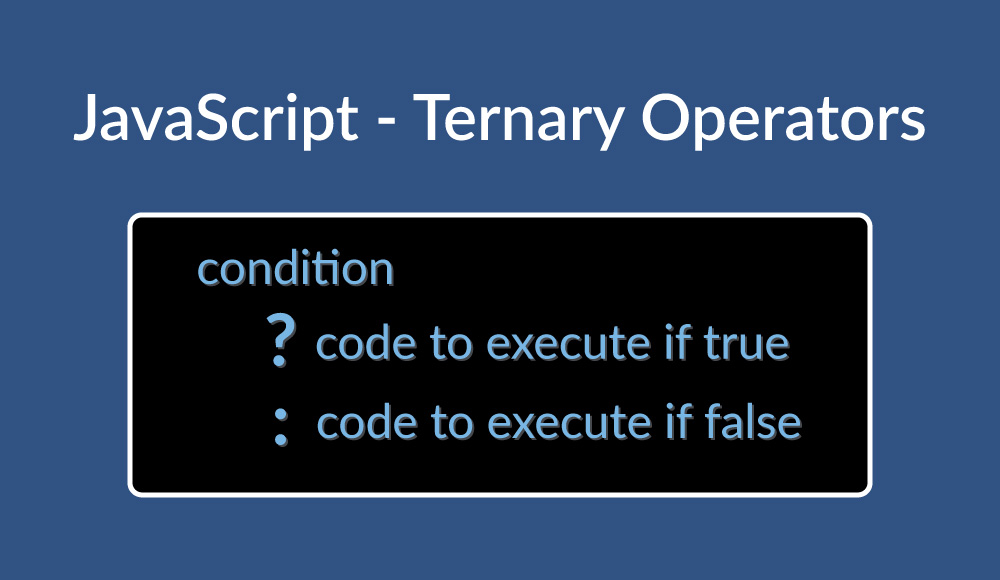JavaScript Operators - Ternary Operators
JavaScript includes one operator that features three operands. This is called the ternary operator. This post continues the series on javascript operators, including the unary and binary operators. The ternary operator is sometimes called a conditional operator and is used often for a shortened version of the if...else statement. Using the ternary operator can help to condense code, although is sometimes criticized for being less transparent and readable code compared to the if...else statement.

Constructing a Ternary Operators
The ternary operator, as the name implies, requires three operands. The ternary operator statement includes a condition, which is evaluated. The conditional statement is followed by a question mark. Upon evaluation, the operator will execute the code before the colon if the result of the condition is true and the code after the colon if the result of the condition is false.
condition (truthy or falsy) ? `code to execute if truthy` : `code to execute if falsy`;
The ternary operator compared with the if..else statement
A ternary operator and an else...if statement are equivalent in terms of the result they return with in a program. The main difference if that a ternary operator is more terse to write.
let price = 35.75;
// using the else...if statement
if (price > 25) {
console.log('too expensive');
} else {
console.log('affordable');
}
// using the ternary operator
price > 25 ? console.log('too expensive') : console.log('affordable');
// result from both statements 'too expensive'
Even though ternary operators are usually used for the evaluation of simple conditions, they can also be used to build more complex conditional statements, including statements that mirror complex if...else statement. The following code example shows how to create a ternary statement that includes an if, elseif, and else combination and the equivalent as a ternary operator.
let name = 'bob cobb';
if (name.includes('melvin')) {
console.log('hello, melvin');
} else if (name.includes('kalvin')) {
console.log('hello, kalvin');
} else {
console.log('hello someone else');
}
name.includes('melvin')
? console.log('hello, melvin')
: name.includes('kalvin')
? console.log('hello, kalvin')
: console.log('hello someone else');
Conditional statements can also include nested conditions on occasion. In the following code example there is a nested if...else statement and the equivalent version as a ternary statement.
let product = { group: 'electronics', name: 'camera', price: 95 };
if (product.group == 'electronics') {
if (product.name == 'camera') {
if (product.price > 75) {
console.log('expensive camera');
} else {
console.log('affordable camera');
}
} else if (product.name == 'computer') {
if (product.price > 500) {
console.log('expensive computer');
} else {
console.log('affordable computer');
}
} else {
console.log('other electronic product');
}
} else {
console.log('other product group');
}
product.group == 'electronics'
? product.name == 'camera'
? product.price > 75
? console.log('expensive camera')
: console.log('affordable camera')
: product.name == 'computer'
? product.price > 500
? console.log('expensive computer')
: console.log('affordable computer')
: console.log('other electronic product')
: console.log('other product group');
The code above shows that although the ternary operator is more condense than an if...else statement, it requires some effort to follow what it’s doing.
The ternary operator useful in situations where a conditional statement is not particularly complex since ternary operators can be difficult to read when they span multiple lines, as reflected in the example above. In situations requiring complex logic, else...if statements are more useful since they tend to be easier to read over multiple lines, especially if they include several or embedded conditional statements.
Variable Assignment
A good example of ternary operator use is when assigning a variable based on a condition.
let department = 'Information Technology';
const isManager = true;
const role = isManager ? `${department} manager` : `${department} staff`;
Here, the variable role is assigned conditionally based on how the isManager boolean is evaluated.
Conclusion
Ternary operators are great for evaluations that are not overly complex, where condensed code helps improve code readability, and in situations where reduced lines of code can be written without compromising its accessibility to other developers.
